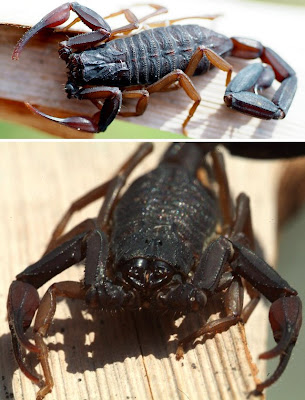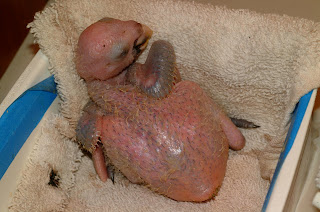Invasive exotics may be responsible for destroying more natural habitat each year than is destroyed through land development. Highly invasive exotic species severely disrupt native ecosystems. They may eliminate or severely alter habitat for wildlife by displacing food plants or altering the structure of the ecosystem. A few problem exotic species are extremely flammable and may pose a danger to humans, as well as wildlife and the native flora, when they burn. Some invasive species can invade and clog waterways. On the other hand, these exotic plants have invaded the natural wildlife of Florida for so long that some native animals have also become accustomed to using these plants for shelter, nest building or food. We, the staff of R.S.C.F., decided to pick a few invasive and native species to talk about and share some pros and cons on these plants.
Invasive Air Potato & MelaleucaThere are over 200 species of Melaleuca (genus Myrtaceae). Both air potato (Dioscorea bulbifera) and melaleuca are invasive plants. Most Melaleuca are native to Australia, and are considered shrubs and trees. They were introduced into Florida in the early 20th century, in an early attempt to dry up the everglades and make it a more agricultural habitat. Now they have swarmed southern Florida making it harder for native plants to grow.
Air potato was introduced to Florida in the early 1900s, and is native to tropical Asia and sub-sahara Africa. It is actually part of the Yam family, which in West Africa is considered a popular food item. However, uncultivated species such as the air potato can be poisonous. It is important to know this if you have animals on your property so they do not eat it accidentally. The best way to get rid of it is to dig up the root and remove it from the ground.
It is important for us to understand the problems with invasive plants. They drown out native plants, taking them longer to grow, if at all. With that being said, the animals that rely on those plants just lost their habitat, and it’s a vicious never-ending cycle. It just goes to show how one little invasive plant can make such a difference in the ecology of an area.
Brazilian Pepper vs. Dahoon HollySinus terebinthifolius goes by many common names: Florida Holly, Christmas berry, Rose Pepper, but the more proper name would be Brazilian Pepper since it came from South America. It was introduced as an ornamental plant in the late 1800s and has now almost completely replaced many native floras such as the similar-looking Dahoon Holly. This holly (Ilex cassine) is a Florida native and it fights to regain a foothold as the Brazilian Pepper continues to blanket the landscape.
Both species are similar in appearance, but have differences to look for. The pepper grows more like a large bush with veined green leaves whereas the holly grows rather straight like a tree with darker glossy leaves. They both produce berries (in the female plants, not males), but at different parts of the year. The Brazilian's berry is dry while the Dahoon Holly's is juicy (but surprisingly disgusting) and the Pepper produces more berries per plant than the Dahoon so it spreads exceedingly faster. The berries are a very important food source for wintering songbirds. American robins wintering in Florida eat tons of "Florida holly" berries, and their population has probably increased since this weed was brought to Florida. It is, in fact, the birds that have spread Brazilian pepper all around. The seeds pass through their stomachs and germinate in little plops of fertilizer! Honey bees also make honey from the flowers.
Today, efforts have been put towards projects to eradicate the berried devil from Florida's landscape. It's a slow process because in order to remove it completely the land has to be practically clear-cut to ensure no remaining seeds, roots, or saplings. As Florida citizens however, we have a moral responsibility to try and keep our state intact with natives and remove what we can from our individual properties and although the work can be tedious at least there is a drive if not towards eradication than towards control.
Native Pines vs. Australian PinesIn North America there are 36 native species of Pines (genus Pinus). Pines are important for various reasons such as food, colonization of burned sites, cover for wildlife, and members of this group are sometimes used for reforestation. These trees reproduce through their cones. The small male cones provide pollen and the larger woody cones which provide the seeds usually have sharp prickled tips. Throughout Florida we have several Pine species such as Spruce Pine, Sand Pine, Loblolly Pine and Slash Pine. Due to the removal of Shortleaf Pine and Longleaf Pine, endangered Red Cockaded Woodpecker populations have plummeted. Also found in Palm Beach, Florida is a non-native flowering tree, which looks just like a pine called Australian Pine or Horsetail Casuarina. These trees were introduced to North America mostly to control erosion and improve soil fertility. Ironically this non-native tree provides a permanent home for a small population of non-native but very endangered Green-cheeked Amazon Parrots. This small population could be vital to the species for future reintroduction to east-central Mexico where its native range lies. Green-cheeked Amazon populations in Palm Beach, Florida are controlled by a finite number of Australian Pine, which are used as nest cavities. Rare Species Conservatory Foundation is home to a small rescued Captive population of a few individuals.
What can one person do?Dealing with invasive plants is a Catch-22. They can cause serious damage to the native wildlife, however some animals have learned to cope with these plants and use them for security and food. They are typically difficult to eradicate. Hand clearing, broad-scale use of herbicide, bio-control, fire, flooding, and clearing followed by herbicide use are just some of the options used to control problem plants. It is nearly impossible to completely remove all exotics in Florida. There are so many exotics and invasive plants that have overrun the habitat it would simply cause mass habitat destruction if all exotics were cleared out. However, one can focus on keeping sections or islands of native plants, while keeping other areas of exotics maintained.
• Become informed, and share your knowledge.
• Learn how to tell the invasive exotics from less dangerous species.
• Remove invasive exotics from your own yard or land.
• Don't use nearby natural areas as places to throw yard debris.
• Volunteer to remove exotics from natural areas.
• Support bio-control programs.
• Let your elected representatives know that you support the control of exotic species.
Florida Native Plant Society:
http://www.fnps.org/pages/plants/invasives.php
Floridata:
http://www.floridata.com/index.cfm


















